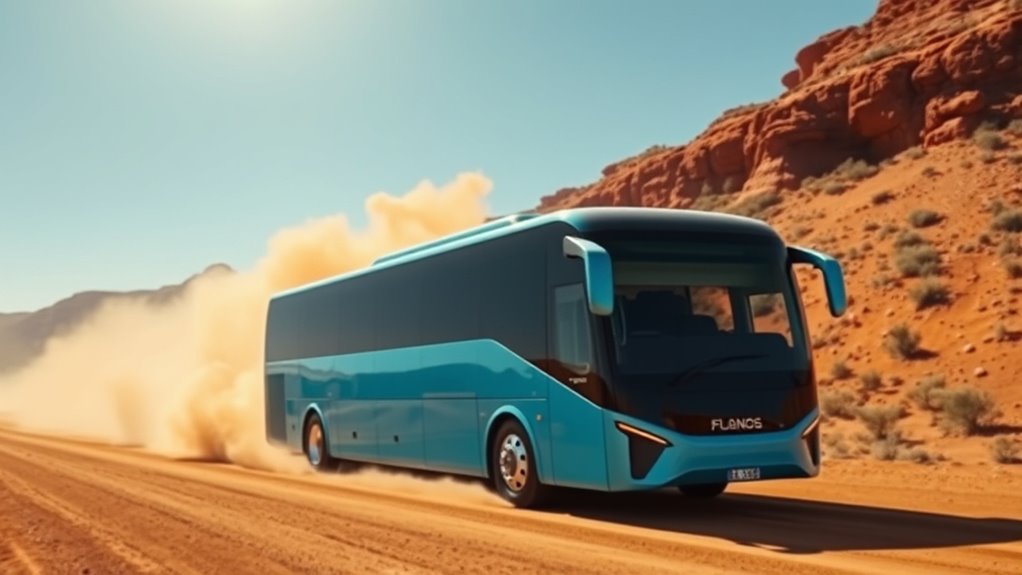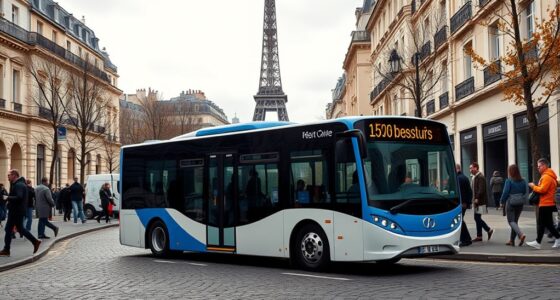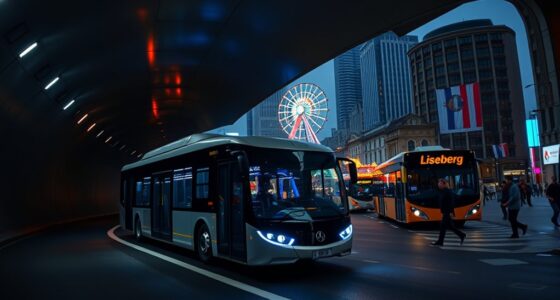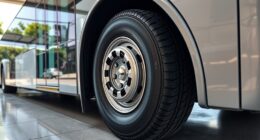Australia’s experience with electric buses in harsh climates shows that advanced, high-energy-density batteries and resilient infrastructure are key to successful deployment. Buses designed to withstand extreme heat and cold, along with fast-charging stations, help overcome environmental challenges. Investing in reliable power grids and integrating renewable energy enhances operational stability. If you want to learn how these innovations can shape sustainable transit solutions in extreme conditions, there’s more to discover below.
Key Takeaways
- High-energy-density batteries designed for extreme heat and cold enhance electric bus reliability in harsh climates.
- Australia’s testing and innovation in climate-resilient batteries inform global deployment strategies.
- Infrastructure resilience, including renewable-powered fast chargers, is crucial to ensure consistent operation amid power disruptions.
- Long-term environmental and operational savings justify investments despite initial high infrastructure costs.
- Australia’s successful fleet transition offers valuable insights for implementing electric buses in other extreme climate regions worldwide.

Electric buses are increasingly becoming essential for sustainable transport in Australia’s challenging climates. With over 200 battery electric buses already operating in New South Wales alone, the country is making significant strides toward replacing traditional diesel and CNG fleets. Your government’s commitment to reaching net zero emissions by 2050 fuels this shift, pushing the transport sector to adopt cleaner, more efficient vehicles.
Australia’s harsh climate, characterized by extreme heat in many regions and occasional cold spells, presents unique challenges for electric bus operation. Yet, technological advances have equipped these buses to withstand and perform reliably under such conditions.
You’ll find that Australian-designed electric buses feature high-energy-density batteries, which enable longer range and better efficiency. Some batteries operate without cooling systems, effectively handling Australia’s high temperatures without compromising performance. This innovation reduces maintenance needs and enhances operational reliability. Additionally, ongoing research into climate-resilient battery technology continues to improve performance in extreme conditions.
Fast-charging infrastructure, like Tritium’s chargers in Victoria, supports rapid recharging, minimizing downtime and keeping buses on schedule. The design of these vehicles takes into account the diverse Australian environment, with lighter batteries that improve weight distribution and load capacity. These advancements allow electric buses to operate efficiently even in regional areas, though challenges remain.
In regional parts of Australia, weak electricity grids and frequent power outages hinder electric bus operations. Limited charging infrastructure in rural zones compounds these difficulties, making it harder to maintain consistent service. Power disruptions can temporarily halt bus fleets, emphasizing the need for resilient energy solutions in these regions. Implementing resilient energy solutions can help overcome these operational hurdles. Moreover, integrating renewable energy sources into the local grid can further enhance the reliability and sustainability of electric bus operations.
Despite these hurdles, the environmental benefits of electric buses are clear. They greatly reduce greenhouse gas emissions, helping Australia meet its climate goals. Replacing diesel buses also improves urban air quality, reducing harmful pollutants and benefiting public health.
The shift to electric buses isn’t just about technology; it’s a sector-wide transformation driven by government policies. Australia’s commitment to net zero targets encourages investments in charging infrastructure and fleet upgrades. Additionally, advancements in high-energy-density batteries are critical for optimizing performance in harsh climates.
States like New South Wales and Victoria are spearheading these efforts, transitioning their bus fleets to electric and supporting local manufacturing of Australian-designed vehicles. Though the cost of infrastructure and vehicles remains high, the long-term environmental and operational savings justify the investment.
You’ll also see growing public acceptance as electric buses prove their reliability and efficiency, even under Australia’s extreme conditions.
In essence, Australia’s experience offers valuable lessons for deploying electric buses in harsh climates worldwide. By adopting advanced battery technology, building resilient infrastructure, and aligning policies with climate goals, you can overcome operational challenges and realize the full potential of electric buses in demanding environments.
Frequently Asked Questions
How Do Electric Buses Handle Extreme Temperature Fluctuations?
You might wonder how electric buses handle extreme temperature fluctuations. They rely on advanced thermal management systems to maintain battery performance and passenger comfort.
In cold weather, insulation and efficient heating keep batteries warm, while in hot conditions, cooling systems prevent overheating.
Upgraded battery tech and smart charging strategies help maximize range and reliability.
What Maintenance Challenges Do Electric Buses Face in Harsh Climates?
Imagine facing relentless cold, where your electric bus battles the elements daily. You’ll find increased maintenance needs, from inspecting electrical systems to managing battery degradation caused by low temperatures.
Harsh climates strain heating systems and charging infrastructure, demanding frequent checks and repairs. To keep your fleet running smoothly, you must adopt proactive monitoring and climate-specific maintenance strategies—turning these challenges into opportunities for resilience and long-term success.
Are Electric Buses More Vulnerable to Sand and Dust Damage?
You might wonder if electric buses are more vulnerable to sand and dust damage. They can be, especially if dust infiltrates batteries, cooling systems, and sensors.
Dust accumulation can cause overheating, corrosion, and sensor fouling, impacting performance and longevity.
However, with proper sealing, advanced filtration, and regular maintenance, you can markedly reduce these risks, ensuring the buses operate reliably even in harsh, dusty environments.
How Do Battery Performances Vary in Prolonged Hot or Cold Conditions?
You might think batteries perform consistently regardless of weather, but prolonged hot or cold conditions actually impact them considerably.
In cold weather, batteries lose capacity and efficiency, reducing range.
In hot weather, they risk overheating, which also hampers performance.
To keep your electric bus operating ideally, you need effective thermal management systems, preheating, cooling strategies, and proper maintenance to mitigate these temperature-related challenges.
What Strategies Are Used to Improve Charging Infrastructure in Remote Areas?
You can improve charging infrastructure in remote areas by deploying modular, scalable systems like containerized chargers tailored for rural needs.
Prioritize high-traffic routes and co-locate chargers with amenities to boost usage.
Collaborate with energy providers to enhance grid capacity, incorporate renewable energy sources such as solar, and implement smart load management to balance demand.
These strategies guarantee reliable, efficient charging even in challenging, off-grid environments.
Conclusion
As you navigate deploying electric buses in harsh climates, think of them as resilient seeds pushing through tough soil. With proper planning and adaptation, you’ll help these vehicles thrive where others might falter. Embrace the challenges as opportunities to learn and grow, turning your fleet into a vibrant, unstoppable force. Just like a mighty tree reaching for the sky despite the storm, your efforts can lead to sustainable transportation that endures even the harshest conditions.









